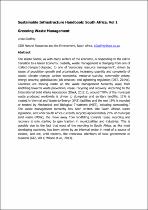JavaScript is disabled for your browser. Some features of this site may not work without it.
- ResearchSpace
- →
- Research Publications/Outputs
- →
- Book Chapters
- →
- View Item
| dc.contributor.author |
Godfrey, Linda K

|
|
| dc.date.accessioned | 2015-12-18T12:42:02Z | |
| dc.date.available | 2015-12-18T12:42:02Z | |
| dc.date.issued | 2014-11 | |
| dc.identifier.citation | Godfrey, L.K. 2014. Greening Waste Management. Sustainable Infrastructure Handbook: South Africa, Vol 1. Alive2green, Cape Town, South Africa | en_US |
| dc.identifier.isbn | 978-0-620-63515-8 | |
| dc.identifier.uri | http://issuu.com/alive2green/docs/infrastructure_handbook_web | |
| dc.identifier.uri | http://hdl.handle.net/10204/8325 | |
| dc.description | Copyright: 2014 Alive2green, Cape Town, South Africa. Due to copyright restrictions, the attached PDF file only contains the abstract of the full text item. For access to the full text item, please consult the publisher's website. | en_US |
| dc.description.abstract | The Waste Sector, as with many sectors of the economy, is responding to the call to transition to a Green Economy. Globally, waste management is changing from one of ‘collect-transport-dispose’, to one of ‘secondary resource management’, driven by issues of population growth and urbanisation; increasing quantity and complexity of waste; climate change; carbon economics; resource scarcity; commodity prices; energy security; globalisation; job creation; and tightening regulation (DST, 2014a). Countries are moving waste up the waste management hierarchy away from landfilling towards waste prevention, reuse, recycling and recovery. According to the International Solid Waste Association (ISWA, 2012:5), around “70% of the municipal waste produced worldwide is driven to dumpsites and sanitary landfills, 11% is treated in thermal and Waste-to-Energy (WtE) facilities and the rest 19% is recycled or treated by Mechanical and Biological Treatment (MBT), including composting.” The waste management hierarchy has been written into South African waste legislation, and while South Africa currently recycles approximately 25% of municipal solid waste (MSW), the move away from landfilling towards reuse, recycling and recovery is only starting to gain traction in municipalities and industries. This is possibly due to the fact that most of the recycling in South Africa, as like most developing countries, has been driven by an informal sector in need of a source of income, and not, until recently, the conscious intentions of local government or business (GIZ, 2011; Wilson et al., 2013). | en_US |
| dc.language.iso | en | en_US |
| dc.publisher | Alive2green | en_US |
| dc.relation.ispartofseries | Workflow;14770 | |
| dc.subject | South African waste management | en_US |
| dc.subject | Green economy | en_US |
| dc.subject | Landfilling | en_US |
| dc.subject | Municipal wastes | en_US |
| dc.title | Greening waste management | en_US |
| dc.type | Book Chapter | en_US |
| dc.identifier.apacitation | Godfrey, L. K. (2014). Greening waste management., <i>Workflow;14770</i> Alive2green. http://hdl.handle.net/10204/8325 | en_ZA |
| dc.identifier.chicagocitation | Godfrey, Linda K. "Greening waste management" In <i>WORKFLOW;14770</i>, n.p.: Alive2green. 2014. http://hdl.handle.net/10204/8325. | en_ZA |
| dc.identifier.vancouvercitation | Godfrey LK. Greening waste management.. Workflow;14770. [place unknown]: Alive2green; 2014. [cited yyyy month dd]. http://hdl.handle.net/10204/8325. | en_ZA |
| dc.identifier.ris | TY - Book Chapter AU - Godfrey, Linda K AB - The Waste Sector, as with many sectors of the economy, is responding to the call to transition to a Green Economy. Globally, waste management is changing from one of ‘collect-transport-dispose’, to one of ‘secondary resource management’, driven by issues of population growth and urbanisation; increasing quantity and complexity of waste; climate change; carbon economics; resource scarcity; commodity prices; energy security; globalisation; job creation; and tightening regulation (DST, 2014a). Countries are moving waste up the waste management hierarchy away from landfilling towards waste prevention, reuse, recycling and recovery. According to the International Solid Waste Association (ISWA, 2012:5), around “70% of the municipal waste produced worldwide is driven to dumpsites and sanitary landfills, 11% is treated in thermal and Waste-to-Energy (WtE) facilities and the rest 19% is recycled or treated by Mechanical and Biological Treatment (MBT), including composting.” The waste management hierarchy has been written into South African waste legislation, and while South Africa currently recycles approximately 25% of municipal solid waste (MSW), the move away from landfilling towards reuse, recycling and recovery is only starting to gain traction in municipalities and industries. This is possibly due to the fact that most of the recycling in South Africa, as like most developing countries, has been driven by an informal sector in need of a source of income, and not, until recently, the conscious intentions of local government or business (GIZ, 2011; Wilson et al., 2013). DA - 2014-11 DB - ResearchSpace DP - CSIR KW - South African waste management KW - Green economy KW - Landfilling KW - Municipal wastes LK - https://researchspace.csir.co.za PY - 2014 SM - 978-0-620-63515-8 T1 - Greening waste management TI - Greening waste management UR - http://hdl.handle.net/10204/8325 ER - | en_ZA |






